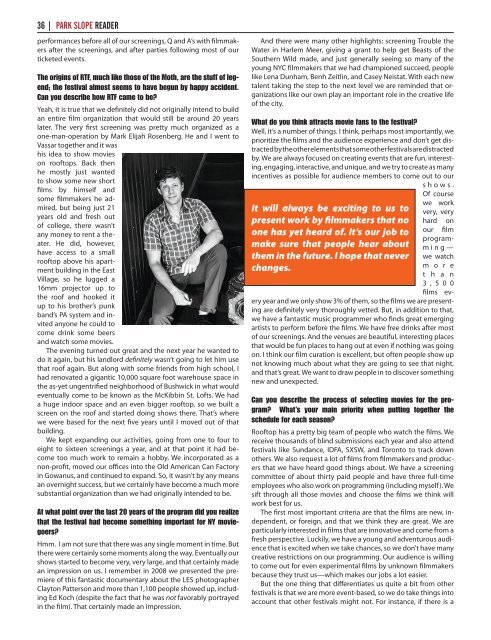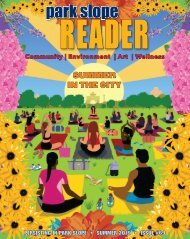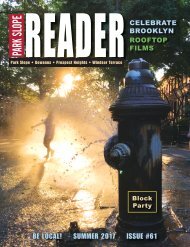PSR_61
Create successful ePaper yourself
Turn your PDF publications into a flip-book with our unique Google optimized e-Paper software.
36 | park slope Reader<br />
performances before all of our screenings, Q and A’s with filmmakers<br />
after the screenings, and after parties following most of our<br />
ticketed events.<br />
The origins of RTF, much like those of the Moth, are the stuff of legend;<br />
the festival almost seems to have begun by happy accident.<br />
Can you describe how RTF came to be?<br />
Yeah, it is true that we definitely did not originally intend to build<br />
an entire film organization that would still be around 20 years<br />
later. The very first screening was pretty much organized as a<br />
one-man-operation by Mark Elijah Rosenberg. He and I went to<br />
Vassar together and it was<br />
his idea to show movies<br />
on rooftops. Back then<br />
he mostly just wanted<br />
to show some new short<br />
films by himself and<br />
some filmmakers he admired,<br />
but being just 21<br />
years old and fresh out<br />
of college, there wasn’t<br />
any money to rent a theater.<br />
He did, however,<br />
have access to a small<br />
rooftop above his apartment<br />
building in the East<br />
Village, so he lugged a<br />
16mm projector up to<br />
the roof and hooked it<br />
up to his brother’s punk<br />
band’s PA system and invited<br />
anyone he could to<br />
come drink some beers<br />
and watch some movies.<br />
The evening turned out great and the next year he wanted to<br />
do it again, but his landlord definitely wasn’t going to let him use<br />
that roof again. But along with some friends from high school, I<br />
had renovated a gigantic 10,000 square foot warehouse space in<br />
the as-yet ungentrified neighborhood of Bushwick in what would<br />
eventually come to be known as the McKibbin St. Lofts. We had<br />
a huge indoor space and an even bigger rooftop, so we built a<br />
screen on the roof and started doing shows there. That’s where<br />
we were based for the next five years until I moved out of that<br />
building.<br />
We kept expanding our activities, going from one to four to<br />
eight to sixteen screenings a year, and at that point it had become<br />
too much work to remain a hobby. We incorporated as a<br />
non-profit, moved our offices into the Old American Can Factory<br />
in Gowanus, and continued to expand. So, it wasn’t by any means<br />
an overnight success, but we certainly have become a much more<br />
substantial organization than we had originally intended to be.<br />
At what point over the last 20 years of the program did you realize<br />
that the festival had become something important for NY moviegoers?<br />
Hmm. I am not sure that there was any single moment in time. But<br />
there were certainly some moments along the way. Eventually our<br />
shows started to become very, very large, and that certainly made<br />
an impression on us. I remember in 2008 we presented the premiere<br />
of this fantastic documentary about the LES photographer<br />
Clayton Patterson and more than 1,100 people showed up, including<br />
Ed Koch (despite the fact that he was not favorably portrayed<br />
in the film). That certainly made an impression.<br />
And there were many other highlights: screening Trouble the<br />
Water in Harlem Meer, giving a grant to help get Beasts of the<br />
Southern Wild made, and just generally seeing so many of the<br />
young NYC filmmakers that we had championed succeed, people<br />
like Lena Dunham, Benh Zeitlin, and Casey Neistat. With each new<br />
talent taking the step to the next level we are reminded that organizations<br />
like our own play an important role in the creative life<br />
of the city.<br />
What do you think attracts movie fans to the festival?<br />
Well, it’s a number of things. I think, perhaps most importantly, we<br />
prioritize the films and the audience experience and don’t get distracted<br />
by the other elements that some other festivals are distracted<br />
by. We are always focused on creating events that are fun, interesting,<br />
engaging, interactive, and unique, and we try to create as many<br />
incentives as possible for audience members to come out to our<br />
shows.<br />
Of course<br />
It will always be exciting to us to<br />
present work by filmmakers that no<br />
one has yet heard of. It’s our job to<br />
make sure that people hear about<br />
them in the future. I hope that never<br />
changes.<br />
we work<br />
very, very<br />
hard on<br />
our film<br />
programming—<br />
we watch<br />
m o r e<br />
t h a n<br />
3 , 5 0 0<br />
films every<br />
year and we only show 3% of them, so the films we are presenting<br />
are definitely very thoroughly vetted. But, in addition to that,<br />
we have a fantastic music programmer who finds great emerging<br />
artists to perform before the films. We have free drinks after most<br />
of our screenings. And the venues are beautiful, interesting places<br />
that would be fun places to hang out at even if nothing was going<br />
on. I think our film curation is excellent, but often people show up<br />
not knowing much about what they are going to see that night,<br />
and that’s great. We want to draw people in to discover something<br />
new and unexpected.<br />
Can you describe the process of selecting movies for the program?<br />
What’s your main priority when putting together the<br />
schedule for each season?<br />
Rooftop has a pretty big team of people who watch the films. We<br />
receive thousands of blind submissions each year and also attend<br />
festivals like Sundance, IDFA, SXSW, and Toronto to track down<br />
others. We also request a lot of films from filmmakers and producers<br />
that we have heard good things about. We have a screening<br />
committee of about thirty paid people and have three full-time<br />
employees who also work on programming (including myself). We<br />
sift through all those movies and choose the films we think will<br />
work best for us.<br />
The first most important criteria are that the films are new, independent,<br />
or foreign, and that we think they are great. We are<br />
particularly interested in films that are innovative and come from a<br />
fresh perspective. Luckily, we have a young and adventurous audience<br />
that is excited when we take chances, so we don’t have many<br />
creative restrictions on our programming. Our audience is willing<br />
to come out for even experimental films by unknown filmmakers<br />
because they trust us—which makes our jobs a lot easier.<br />
But the one thing that differentiates us quite a bit from other<br />
festivals is that we are more event-based, so we do take things into<br />
account that other festivals might not. For instance, if there is a












